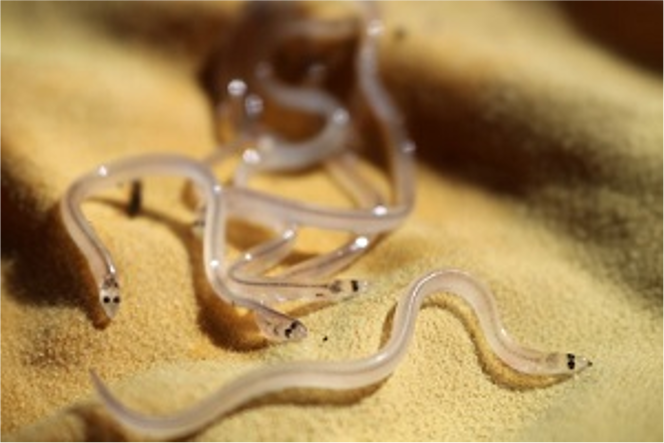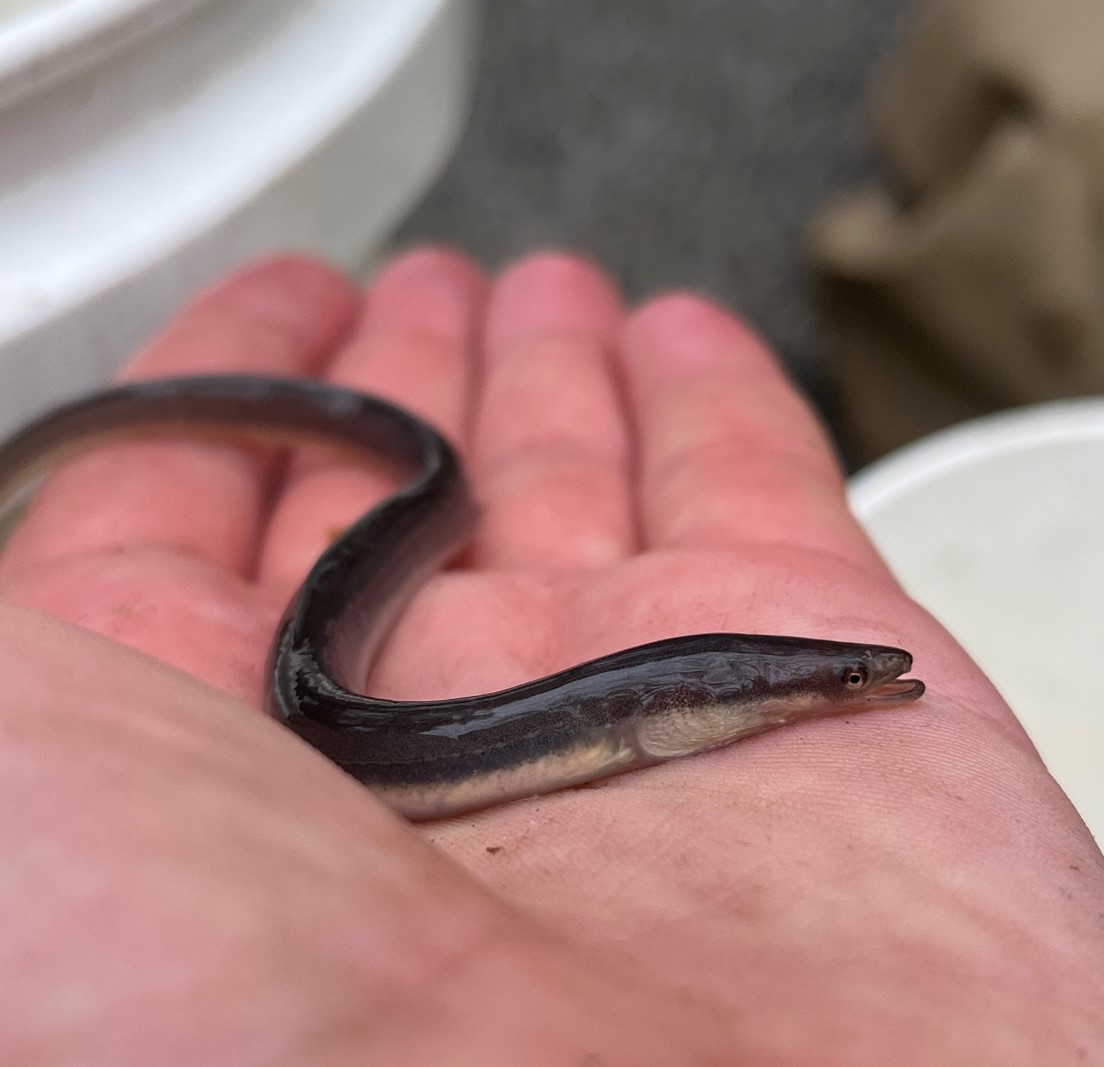Picture this: it’s early Spring, the cold air still nips at your nose, but the sun has finally arrived with the promise of a lush green season. Not knowing when you’ll get another sunny day without rain, you decide to take a walk along your favorite spot on the Raritan. You’re pocketing some cool pieces of broken pottery, finding some animal tracks, and picking through scat, a.k.a wildlife feces, (ok, maybe that’s just me…) when you notice a beautiful, large rock along the stream bank.
You schlepp on over through a thorny bush; it pricks you, but the rock vows to be worth the pain of the journey. Maybe you step on some skunk cabbage and gag a bit as the fumes overtake your nostrils. You grasp the alluring crystal, cold water rushing over your fingertips. And as your eyes begin to transfix on the shimmering facets of the quartz, you notice something dart out from the hollow of the rock’s bed.

Glass eels. Picture credit to Sarah Mount, NYSDEC
What was that??
Kneeling, you see a miniscule, translucent filament – the tail of some snake-like creature cramming itself beneath the nearest refuge. Perhaps it freaks you out a bit, but you’re brave. So, you pick up the rock and see the creature in its full glory: a writhing, animated glass noodle. It’s longer than your pinky finger and just as skinny as the spaghetti you had for dinner last night. It has two tiny, jet-black eyes; you can even see its equally tiny red heart beating in its chest.
It’s a glass eel!
Ah, how lucky you are!
Glass eels are the juvenile life-stage of the American eel, an elusive, sought-after fish native to tributaries of the eastern coasts of the Americas. Arriving in early spring after a thousand-mile journey from their Sargasso Sea spawning grounds near Bermuda, glass eels make their way up the NY-NJ Harbor Estuary, into the Raritan and Hudson rivers and eventually settle-in to cozy riverbeds, ponds, and lakes; beyond our region this is taking place throughout all the watersheds of the Atlantic.
We tend to see glass eels in their true, glassy, forms in about February and March of each year. At this point in their lives, they’re about one year old. They have already undergone a major metamorphosis from their leptocephalus (meaning ‘narrow head’ in Latin) larval form. As leptocephali, they ride the Gulf Stream as they’re swept along the currents – elongating and narrowing into glass eels – and eventually exit near estuaries along the coastline.
Using their powerful sense of smell, glass eels find sources of freshwater to migrate inland and seek out suitable habitat to live their lives. If you’re lucky, you may experience a phenomenon known as eel braids. These ‘braids’ are huge swaths of eels swimming together upstream from brackish to freshwater. Juvenile eels bring into estuaries massive quantities of marine-derived energy; migrating birds and resident fish, hungry from the cold winter, have learned to capitalize on the eel migration, snacking away on the crunchy and salty eels.
Throughout the Spring, as they migrate inland through freshwater, glass eels develop dark pigments in their skin to blend into their new homes. Some eels will choose to live close to the estuaries, some even moving back and forth across estuaries; most will move inland.

Elver eel
When the next spring after their journey from the sea comes around, we call them elvers. At this point, they’re usually about 3 inches long, dark brown-grey, and a bit thicker than their juvenile, glassy brethren.
An eel is quite stationary once they find a suitable habitat, which is usually rocky-bottom streams with an abundance of macroinvertebrates (their favorite food). It takes a while – perhaps 4 to 7 years – for an eel to become what we call a yellow eel; technically speaking, this occurs when the eel reaches six inches in length. After a while longer of eating and growing, an eel finally develops a gender. That’s right: most of their lives, eels are asexual. Now the real fun begins for the eels.
Male eels, once they reach the yellow eel life-stage, may stick around in freshwater for a few more years before they’re ready to reproduce. After this, they’re ready to swim back to their breeding grounds. They begin this journey in late Fall, on dark and rainy nights. Female eels will stay quite a while longer; they’re usually about 15 to 20 years old when they start to make their journey to breed. However, it’s been reported that females can live up to thirty years or more before being ready to reproduce. As eels reach the point of sexual maturity, we call them silver eels because of the bronze-silver coloration they develop on their sides to blend in which the shiny waters of the Atlantic Ocean. At this point, they are simultaneously growing significantly larger eyes and pectoral fins to aid in their long trip through the Atlantic.
When they exit estuaries along the coast, eels stop eating and a new, major, metamorphosis has begun. Inside their bodies, eels are breaking down their digestive tracts and digesting fat from their years of eating and growing, filling up their body cavities with gonads. This is why females take so much longer to fully mature: their bodies must hold enough fat to fuel the production of six to eight million eggs. The males’ sperm are far less energy intensive.
To my knowledge, only one study has successfully shown an American eel’s journey back to the mid-Atlantic. In 2015, researchers out of Canada managed to track a female, using a satellite tracker, almost to the Sargasso. This trip, from Nova Scotia to the Sargasso region, took the eel around forty days of constant swimming. Remember: this journey took the juveniles a year of passive transport (floating) along the Gulf Stream. And this female didn’t just swim straight there, she took vertical journeys up and down through the water column daily, swimming near the surface at night and the dark depths during the day, nearly tripling her journey.
Now I can’t really speak about the eels’ reproduction because no one has actually seen it happen. We don’t even know exactly where it happens, just that it’s somewhere in the vicinity of the Sargasso Sea. Some describe it as likely a mass-breeding event. Others think it’s more intimate for the eels. All we know is that there is a very minimal homing instinct in eels, meaning juveniles do not typically seek out the same waters as their parents. This leads some scientists to believe that eels reproduce randomly en masse. We also know that after reproducing, the eels die, donating the remaining nutrients and energy of their carcass back to the earth.
Eels are incredible creatures; But they are also in trouble.
Dams, water pollution, poaching, and environmental destruction have negatively impacted American eel populations across the Americas. Dams prevent open migration of juvenile eels in the spring, concentrating populations in smaller stretches of rivers and leaving them more vulnerable to predation and competition. Water pollution puts pressure on their sensitive bodies while also lessening the abundance of their prey. Populations crashed in the eighties due to unrestricted poaching. And while the American eel is now far more protected, eels are still in danger.
Eels are a keystone species. Early life-forms provide necessary food to a suite of predators. Larger, female eels will be the apex predator of a small, inland stream, thereby regulating populations of smaller predator fish throughout their community. Eels span the entire food web, providing critical ecosystem services at every life-stage.
And while eels are incredibly resilient creatures, nothing is entirely immune to the pressures we place on ecosystems. We must act responsibly and use sense before making decisions that impact lives beyond our own.
Take a walk along the river in early spring. Enjoy the beauty of the Raritan River. If you’re patient and determined, you’ll likely see a glass eel.



